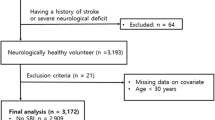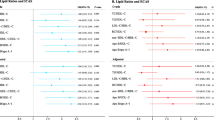Abstract
The extent of carotid artery atherosclerosis correlates with increased plasma concentrations of total cholesterol (TC) and low-density lipoprotein-cholesterol (LDL-C) and with a decreased plasma concentration of high-density lipoprotein-cholesterol (HDL-C). However, emerging data suggest that a triglyceride (TG):HDL-C ratio may be a better predictor of vascular risk than the traditional lipid measures such as TC and LDL-C. The purpose of this study was to evaluate the association between TC, LDL-C, TG, HDL-C, and the TG:HDL-C ratio with steno-occlusive disease in the intracranial cerebral arteries. We analyzed the records of 361 stroke-free subjects who underwent brain magnetic resonance angiography as part of their voluntary health checks. The presence of a steno-occlusive lesion in the basilar artery (BA) and in the horizontal portion of the middle cerebral artery (MCA) was assessed using brain 3D time of flight magnetic resonance angiography. All patients had fasting lipid panels drawn. We categorized serum lipid indices into quartiles and logistic regression analyses were performed. No serum lipid index was associated with the prevalence of MCA disease; TC, LDL-C, and HDL-C concentrations were not correlated with the prevalence of BA disease. A TG concentration in the third quartile compared with the lowest quartile was associated with increased prevalence of BA disease. The TG:HDL-C ratios in the upper three quartiles compared with the lowest quartile were associated with increased prevalence of BA disease. In conclusion, the TG:HDL-C ratio is more highly associated with the intracranial steno-occlusive disease than any standard lipid measure.
Similar content being viewed by others
References
Uehara T, Tabuchi M, Mori E (2005) Risk factors for occlusive lesions of intracranial arteries in stroke-free Japanese. Eur J Neurol 12:218–222
Uehara T, Tabuchi M, Mori E (1998) Frequency and clinical correlates of occlusive lesions of cerebral arteries in Japanese patients without stroke. Evaluation by MR angiography. Cerebrovasc Dis 8:267–272
Caplan LR, Gorelick PB, Hier DB (1986) Race, sex, and occlusive cerebrovascular disease: a review. Stroke 17:648–655
Salonen R, Seppanen K, Rauramaa R, Salonen JT (1988) Prevalence of carotid atherosclerosis and serum cholesterol levels in eastern Finland. Arteriosclerosis 8:788–792
Crouse JR, Toole JF, McKinney WM, Dignan MB, Howard G, Kahl FR, McMahan MR, Harpold GH (1987) Risk factors for extracranial carotid artery atherosclerosis. Stroke 18:990–996
Fine-Edelstein JS, Wolf PA, O’Leary DH, Poehlman H, Belanger AJ, Kase CS, D’Agostino RB (1994) Precursors of extracranial carotid atherosclerosis in the Framingham study. Neurology 44:1046–1050
Bang OY, Saver JL, Liebeskind DS, Pineda S, Ovbiagele B (2008) Association of serum lipid indices with large artery atherosclerotic stroke. Neurology 70:841–847
Kurth T, Everett BM, Buring JE, Kase CS, Ridker PM, Gaziano JM (2007) Lipid levels and the risk of ischemic stroke in women. Neurology 68:556–562
Ridker PM, Rifai N, Cook NR, Bradwin G, Buring JE (2005) Non-HDL cholesterol, apolipoproteins A-I and B100, standard lipid measures, lipid ratios, and CRP as risk factors for cardiovascular disease in women. JAMA 294:326–333
Kinosian B, Glick H, Garland G (1994) Cholesterol and coronary heart disease: predicting risks by levels and ratios. Ann Intern Med 121:641–647
Pischon T, Girman CJ, Sacks FM, Rifai N, Stampfer MJ, Rimm EB (2005) Non-high-density lipoprotein-cholesterol and apolipoprotein B in the prediction of coronary heart disease in men. Circulation 112:3375–3383
Boizel R, Benhamou PY, Lardy B, Laporte F, Foulon T, Halimi S (2000) Ratio of triglycerides to HDL cholesterol is an indicator of LDL particle size in patients with type 2 diabetes and normal HDL cholesterol levels. Diabetes Care 23:1679–1685
Yasaka M, Yamaguchi T, Shichiri M (1993) Distribution of atherosclerosis and risk factors in atherothrombotic occlusion. Stroke 24:206–211
Friedewald WT, Levy RI, Fredrickson DS (1972) Estimation of the concentration of low-density lipoprotein-cholesterol in plasma, without use of the preparative ultracentrifuge. Clin Chem 18:499–502
Chen Y, Zhang X, Pan B, Jin X, Yao H, Chen B, Zou Y, Ge J, Chen H (2010) A modified formula for calculating low-density lipoprotein-cholesterol values. Lipids Health Dis 9:52
Kang K, Lee SH, Yoon BW (2009) Basilar artery steno-occlusive disease is associated with structural changes in the left ventricle. Acta Cardiol 64:493–498
Uehara T, Mori E, Tabuchi M, Ohsumi Y, Yamadori A (1994) Detection of occlusive lesions in intracranial arteries by three-dimensional time-of-flight magnetic resonance angiography. Cerebrovasc Dis 4:365–370
Kwon SU, Cho YJ, Koo JS, Bae HJ, Lee YS, Hong KS, Lee JH, Kim JS (2005) Cilostazol prevents the progression of the symptomatic intracranial arterial stenosis: the multicenter double-blind placebo-controlled trial of cilostazol in symptomatic intracranial arterial stenosis. Stroke 36:782–786
Goldstein LB, Adams R, Alberts MJ, Appel LJ, Brass LM, Bushnell CD, Culebras A, Degraba TJ, Gorelick PB, Guyton JR, Hart RG, Howard G, Kelly-Hayes M, Nixon JV, Sacco RL (2006) Primary prevention of ischemic stroke: a guideline from the American Heart Association/American Stroke Association Stroke Council: cosponsored by the Atherosclerotic Peripheral Vascular Disease Interdisciplinary Working Group; Cardiovascular Nursing Council; Clinical Cardiology Council; Nutrition, Physical Activity, and Metabolism Council; and the Quality of Care and Outcomes Research Interdisciplinary Working Group: the American Academy of Neurology affirms the value of this guideline. Stroke 37:1583–1633
Tanne D, Koren-Morag N, Graff E, Goldbourt U (2001) Blood lipids and first-ever ischemic stroke/transient ischemic attack in the Bezafibrate Infarction Prevention (BIP) Registry: high triglycerides constitute an independent risk factor. Circulation 104:2892–2897
Gordon T, Kannel WB, Castelli WP, Dawber TR (1981) Lipoproteins, cardiovascular disease, and death. The Framingham study. Arch Intern Med 141:1128–1131
Lindenstrom E, Boysen G, Nyboe J (1994) Influence of total cholesterol, high density lipoprotein-cholesterol, and triglycerides on risk of cerebrovascular disease: the Copenhagen city heart Study. BMJ 309:11–15
Koren-Morag N, Tanne D, Graff E, Goldbourt U (2002) Low- and high-density lipoprotein-cholesterol and ischemic cerebrovascular disease: the bezafibrate infarction prevention registry. Arch Intern Med 162:993–999
Leppala JM, Virtamo J, Fogelholm R, Albanes D, Heinonen OP (1999) Different risk factors for different stroke subtypes: association of blood pressure, cholesterol, and antioxidants. Stroke 30:2535–2540
Wannamethee SG, Shaper AG, Ebrahim S (2000) HDL-cholesterol, total cholesterol, and the risk of stroke in middle-aged British men. Stroke 31:1882–1888
Soyama Y, Miura K, Morikawa Y, Nishijo M, Nakanishi Y, Naruse Y, Kagamimori S, Nakagawa H (2003) High-density lipoprotein-cholesterol and risk of stroke in Japanese men and women: the Oyabe study. Stroke 34:863–868
Lamarche B, Lemieux I, Despres JP (1999) The small, dense LDL phenotype and the risk of coronary heart disease: epidemiology, patho-physiology and therapeutic aspects. Diabetes Metab 25:199–211
St-Pierre AC, Ruel IL, Cantin B, Dagenais GR, Bernard PM, Despres JP, Lamarche B (2001) Comparison of various electrophoretic characteristics of LDL particles and their relationship to the risk of ischemic heart disease. Circulation 104:2295–2299
Dobiasova M, Frohlich J (2001) The plasma parameter log (TG/HDL-C) as an atherogenic index: correlation with lipoprotein particle size and esterification rate in apoB-lipoprotein-depleted plasma (FER(HDL)). Clin Biochem 34:583–588
Dobiasova M, Stribrna J, Sparks DL, Pritchard PH, Frohlich JJ (1991) Cholesterol esterification rates in very low density lipoprotein- and low density lipoprotein-depleted plasma. Relation to high density lipoprotein subspecies, sex, hyperlipidemia, and coronary artery disease. Arterioscler Thromb 11:64–70
Dobiasova M, Stribrna J, Pritchard PH, Frohlich JJ (1992) Cholesterol esterification rate in plasma depleted of very low and low density lipoproteins is controlled by the proportion of HDL2 and HDL3 subclasses: study in hypertensive and normal middle-aged and septuagenarian men. J Lipid Res 33:1411–1418
St-Pierre AC, Cantin B, Dagenais GR, Mauriege P, Despres JP, Lamarche B (2004) The triglyceride/high-density lipoprotein-cholesterol ratio, the small dense low-density lipoprotein phenotype, and ischemic heart disease risk. Metab Syndr Relat Disord 2:57–64
Frohlich J, Dobiasova M (2003) Fractional esterification rate of cholesterol and ratio of triglycerides to HDL-cholesterol are powerful predictors of positive findings on coronary angiography. Clin Chem 49:1873–1880
Acknowledgment
This study was supported by a grant of the Korea Health 21 R&D Project, Ministry of Health, Welfare and Family Affairs, Republic of Korea (A060171).
Author information
Authors and Affiliations
Corresponding author
Rights and permissions
About this article
Cite this article
Kang, K., Lee, K. & Chung, SH. The triglyceride:high-density lipoprotein-cholesterol ratio and steno-occlusive disease in the intracranial arteries. J Thromb Thrombolysis 32, 103–109 (2011). https://doi.org/10.1007/s11239-011-0553-1
Published:
Issue Date:
DOI: https://doi.org/10.1007/s11239-011-0553-1




